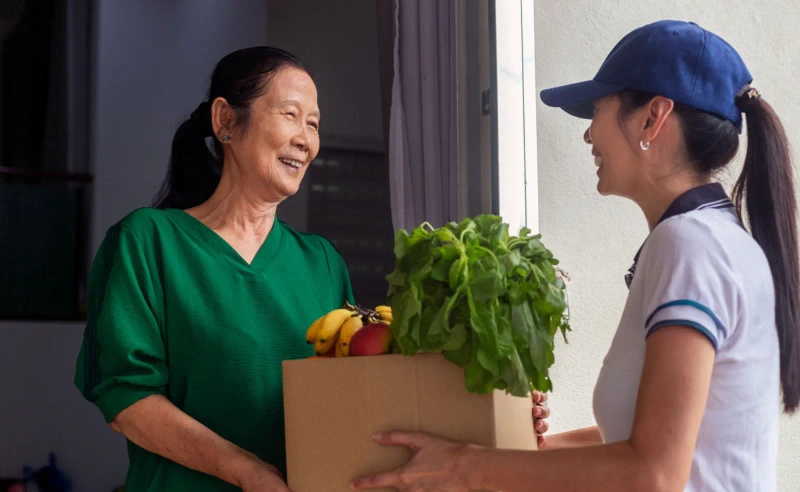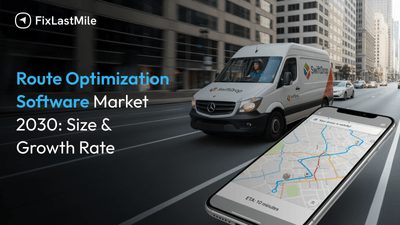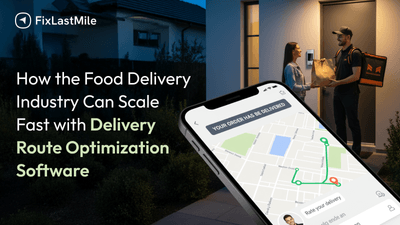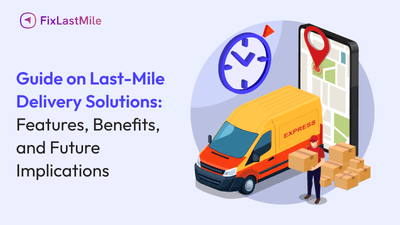Picture this: It’s 6:45 PM. A working parent gets home, starts dinner prep, and realizes they’ve run out of essentials—bread, milk, and fresh vegetables. They grab their phone, place an order through their grocery app, and expect everything delivered within 60 minutes. Not 2 hours. Not the next day. Right now.
This isn't a rare scenario anymore. It’s now what customers expect from every grocery service.
Consumers expect speed. The pressure on businesses to meet those expectations—consistently and profitably—is at an all-time high. Whether you're an operations manager at a grocery chain or a founder of a q-commerce startup, delivering groceries fast isn't just a competitive advantage—it's a necessity.
But meeting 60-minute delivery windows comes with major operational challenges. In this blog, we’ll break down:
- Why this ultra-fast model is becoming non-negotiable
- The logistics barriers holding most grocery delivery teams back
- And the three key strategies you can use to consistently meet—and exceed—delivery expectations
Why 60-Minute Delivery Is No Longer Optional
1. Customer Expectations Have Shifted
Modern consumers, especially in urban areas, live in a world of instant gratification. They’re used to services like ride-hailing, 10-minute food deliveries, and quick package drop-offs. Grocery delivery is no different now. Customers expect their groceries to arrive fast—often in less than an hour.
2. Q-Commerce Is Redefining Speed
Players like Zepto, Getir, and Blinkit have introduced ultra-fast delivery models, often fulfilling orders within 10 to 30 minutes using dark stores and micro-fulfillment hubs. This has raised the bar for the entire industry. If your service takes 90 minutes or longer, chances are customers will try a competitor next time.
3. The Mobile-First Mindset
We live in a mobile-first world. People shop, book services, and communicate using smartphones. They also expect real-time updates and instant service. A clunky ordering process or long delivery window no longer fits the modern customer’s lifestyle.
4. Operational Cost Efficiency
Ironically, the faster you deliver, the more efficient your system can become—if it's optimized. Faster deliveries mean better driver productivity, fewer failed orders, and better route efficiency. Delay deliveries, and you’re facing cancellations, support costs, refunds, and unhappy customers.
Delivering groceries in 60 minutes is no longer just a promise—it’s a survival strategy in today’s fast-paced delivery ecosystem.
The Real Operational Challenges Behind 60-Minute Windows
If 60-minute delivery is the goal, what’s stopping businesses from achieving it consistently?
Here are the most common roadblocks:
- Inefficient routing: Static or manual routes cause drivers to take longer-than-necessary paths.
- Manual dispatching: Assigning deliveries manually slows things down and increases human error.
- Lack of real-time visibility: Operations teams and customers are often in the dark about order progress.
- Poor time slot management: Orders bunch up in certain windows, leading to service delays and SLA breaches.
- No scalability: Most businesses can’t handle spikes in demand, especially during weekends, promotions, or holidays.
These pain points don’t just affect daily operations—they impact customer trust, brand reputation, and profitability.
So, how can you fix them?
Let’s dive into the three core strategies of the grocery delivery software that can help you deliver smarter, faster, and at scale.
Strategy 1: Optimize Routes to Save Time and Cost
One of the biggest challenges in same-day grocery delivery is routing. Most businesses still rely on basic tools or manual processes to assign routes. That’s a major problem.
Why traditional routing fails:
- It doesn’t account for traffic, delivery priorities, or real-time updates.
- Drivers waste time on inefficient paths or make unnecessary detours.
- Orders get delayed, costs rise, and customer satisfaction drops.
What smarter route optimization does:
- Uses real-time traffic and road data
- Reduces travel time by organizing deliveries based on location proximity
- Considers driver location, delivery time slots, and vehicle load
- Adjusts routes dynamically during delivery runs
By leveraging advanced AI-based route optimization software, operations can:
- Deliver more orders per driver
- Reduce fuel costs and idle time
- Hit tighter delivery windows with consistency.
Strategy 2: Automate Time Slot Management
Time slot selection can either make or break a delivery operation. Customers love choosing when their order arrives—but without proper planning, your team ends up with overbooked windows, delayed drivers, and missed SLAs.
Problems with manual time slot handling:
- No logic behind which slots get offered to which customers
- Operations teams overloaded in certain hours
- Missed deliveries, failed attempts, and angry customers
How smart time slot management works:
- Dynamically controls the availability of delivery windows
- Blocks slots based on current fleet capacity and traffic conditions
- Suggests slots that align with optimized routes and real-time data
- Keeps delivery volumes manageable for drivers during rush hours
Benefits of this strategy:
- Balanced delivery workloads
- Higher on-time delivery rates
- Improved customer experience through accurate ETAs
- Fewer cancellations and last-minute rescheduling
Use of automated time slot management helps to increase SLA fulfillment by 26%, while reducing driver overtime costs.
Explore how to automate your time slots with the Route Optimization software.
Strategy 3: Dispatch Smarter with Real-Time Visibility

The final piece of the puzzle is visibility. Most operational teams don’t know where their drivers are at any given time. Without this, you’re left reacting to problems after they’ve occurred.
Common issues without real-time visibility:
- Drivers stuck in traffic without alerts
- Customer complaints due to missed or inaccurate ETAs
- No way to reroute or reassign orders in emergencies
- Inefficient dispatching based on guesswork
Real-time tracking and auto-dispatching solve this by:
- Assigning drivers automatically based on availability, location, and workload
- Providing live GPS tracking for every order
- Offering real-time ETAs to customers and ops teams
- Allowing managers to reassign delayed or missed deliveries instantly
With this level of control, teams can be proactive—not reactive.
A top-tier eGrocery business reduced support calls by 40% after enabling real-time customer tracking and dispatch automation.
How Fixlastmile Supports 60-Minute Delivery at Scale
Fixlastmile is designed to help grocery delivery businesses thrive in the age of instant expectations. Here’s how our grocery delivery software does it:
- Smarter route optimization to reduce delays and cost
- Automated dispatch and reallocation based on real-time updates
- Dynamic time-slot balancing to avoid overcommitment
- Live tracking for customers and operations teams
- Scalable architecture that works whether you're delivering 50 or 5,000 orders/day
With Fixlastmile, you don’t just promise fast delivery—you actually deliver it.
Start delivering in 60 minutes or less—explore Fixlastmile’s grocery delivery software today.
Conclusion: Delivering Fast Is Good. Delivering Smart Is Better.
Same-day grocery delivery in 60 minutes is no longer an edge—it’s the expectation. But speed without strategy leads to burnout, customer churn, and operational chaos.
To succeed in this space, businesses must be proactive, tech-enabled, and data-driven.
With the right logistics strategy—optimized routes, smart time slots, and real-time tracking—you can:
- Delight customers with every order
- Reduce failed deliveries and support costs
- Dynamic time-slot balancing to avoid overcommitment
- Build a scalable, profitable delivery operation that lasts
And that’s exactly what Fixlastmile helps you do.
FAQs
Balancing speed with scale. Most businesses lack the tech to manage fast deliveries across peak hours, dense zones, and shifting customer expectations.
It plans efficient routes based on real-time traffic, order priority, and driver capacity—reducing delays and helping drivers serve more customers in less time.
Yes. Fixlastmile is built to scale with your operations, whether you’re starting with one zone or expanding across cities. It automates key processes, so you can grow without chaos.
Fixlastmile uses real-time traffic updates, order density, delivery time windows, driver location, and vehicle capacity. This ensures routes are optimized for speed and efficiency, even during high-demand hours.
Yes. Fixlastmile offers flexible API integrations and works with most ordering platforms, POS systems, and ERPs to ensure seamless data flow and order visibility across your delivery network.
The platform auto-adjusts routes and time slot availability based on demand and driver load. It also enables dynamic reassignments, helping you manage peak loads without service disruption.




